Stephen Evans, Philip Steadman, Daniel Godoy-Shimizu & Rob Liddiard
Summary
3DStock is a spatially structured, complete building stock model that covers large areas of England and Wales and represents the stock in great detail. The individual building data can be aggregated to a wider geographical scale for generalised analysis. Here, the model is used to explore the relationship between built form, energy use and urban density. Using aggregated (sub-national) metered energy data and aggregated floorspace this paper shows how these results vary with increasing density. By using very large empirical datasets in this way it is shown that density and compactness have a significant influence on the energy use intensity of domestic buildings.
Introduction
According to the Intergovernmental Panel on Climate Change (IPCC), the structure of a building itself is key to the amount of energy consumed and a “more compact urban form tends to reduce consumption due to lower per capita floor areas, reduced building surface to volume ratio, increased shading, and more opportunities for district heating and cooling systems” (Lucon et al 2014, p.696). Despite this significant statement it seems that the relationship between residential density and domestic energy use has been studied theoretically but not, we believe, using actual consumption data at a large geographical scale.
According to the Department for Energy and Climate Change, (DECC, 2013), in climates like that of England and Wales, space heating accounts for around two-thirds of domestic energy use. It is therefore to be expected that overall energy consumption will be affected by built form, and specifically by the areas of exposed walls and roofs through which heat is lost. Steadman, Hamilton and Evans (2014) showed a strong correlation between the total surface area of all non-domestic buildings in London and actual metered use of gas. This relationship could be expected to be even stronger for domestic buildings.
Areas of exposed wall will clearly vary between different types of dwelling: detached houses, semi- detached and end-of-terrace houses, terraced houses and flats. Steemers (2003) presented a purely theoretical calculation of the relationship of heat loss to the ratio of envelope area/ floor area (Figure 1). This showed a ranking in order of apartment: terrace: semi-detached: detached: bungalow (i.e. single-storey detached), going from the lowest to the highest rate of heat loss. Apartments achieved a 40% heat saving per m2 of floor area over detached houses. Steemers (p.6) argued on this basis that “the way to increase density and energy efficiency simultaneously is to increase ‘compactness’ of the urban fabric.”
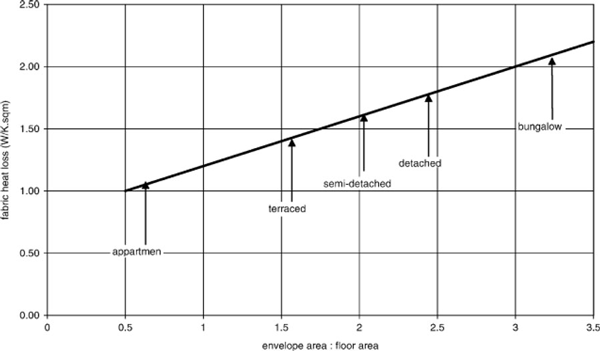
More recently the NHBC Foundation (2016) in a study of the ‘form factor’ in house design calculated the comparative energy performance of a range of dwelling types. They defined the form factor as:
Total heat loss area (walls, roof, floors, openings) (m2)
Habitable floor area of all storeys (m2)
The results showed values for the form factor varying between 0.8 for an ‘end mid-floor apartment’ and 3.0 for a bungalow. Energy consumption for space heating was then estimated using simulation, and compared with the form factor. However, the exercise assumed a standard floor area of 93 m2 for all dwelling types, when in fact there is typically a large increase in mean floor area going from flats to detached houses.
We would expect to find a preponderance of detached houses in low-density suburban areas, and more apartments in higher-density areas towards the centres of cities. But what is the precise relationship of dwelling types to residential densities? Mitchell et al (2011) measured the percentage share of all dwellings represented by each of four types, at different levels of net residential density (dwellings per hectare), for a total of 7697 wards (census districts) in England in 2001. They showed that detached houses dominate at the lowest densities and decline as a percentage, as density increases. Semi-detached houses reach a maximum percentage at around 30 dwellings per hectare, and thereafter also decline. Terraced houses peak around 50 dwellings per hectare. All three types of house are then progressively replaced by flats and maisonettes (duplexes), which reach 90% of all dwellings at around 170 dwellings per hectare (Figure 2). This analysis suggests that we might find a corresponding decrease in heat loss and rise in energy efficiency, as residential density increases.
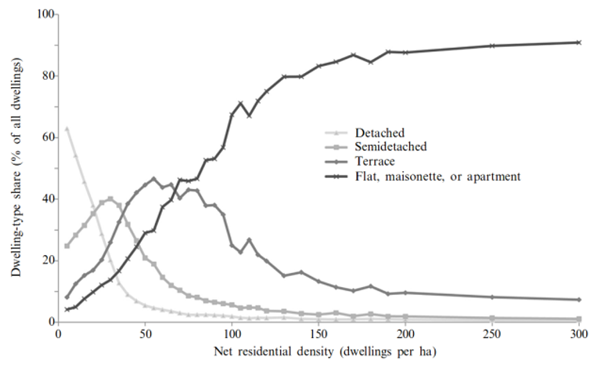
3DStock model
Until recently it was very difficult to build 3D models of the building stock that covered large spatial extents and used detailed large-scale map data, due to computational limitations. Some building stock models have avoided this issue by using archetypes derived from samples of the stock which could then be extrapolated to produce models of energy consumption for different built forms. 3DStock bypasses the need for archetypes by modelling the complete building stock for large areas of England and Wales and then applying actual geolocated metered energy data to the model. The model is built from a range of data sources using automated methods and is stored in a spatial database (Evans et al 2014). 3DStock is an activity-agnostic model storing both domestic and a very detailed breakdown of different non-domestic activities side-by-side in the same model. It also copes well with a wide spectrum of mixed use activity buildings (figure 3) (Evans et al 2016). The model works at a relatively detailed level of granularity (dwelling or premises) and includes activity per floor level and floor areas associated with each activity. The AddressBase product from Ordnance Survey (OS) underpins the model in much the same way as any spatially enabled national gazetteer might. Using address matching techniques we are therefore able to introduce any other address based datasets and match them to the correct address in the gazetteer and from there give them a precise spatial location. Addresses are also given a floor level where possible allowing the model to be fully three dimensional or stratified (Evans et al 2016, p. 235-236). Because the model is stored spatially, attributes from the model (e.g. floorspace, built form, activity, exposed wall area, building height, number of floors and so on) can be queried and aggregated to any spatial extent required. For the purpose of this work we have aggregated the data at the postcode level for reasons that will become clear.
The current model extent includes all of Inner London along with Ealing, Brent, Barking & Dagenham, Haringey, Waltham Forest and Newham (representing over 30% of the area and 50% of the population of London). Outside of London it includes Milton Keynes, Leicester, Tamworth and Swindon. The model covers over 110,000 hectares (1,100 km2) of terrain. For these extents the model includes around 100,000 non-domestic activity buildings or Self Contained Units (SCUs), (Taylor et al. 2014, Evans et al 2014, p.235). There are just over 1.1 million domestic buildings. There are around 19,500 buildings that remain unclassified, usually because they achieve no match in the Valuation Office Agency (VOA) Rating List. These include churches, prisons and law courts which are not domestic, nor are they subject to business rates and are therefore not included in the VOA Rating List.
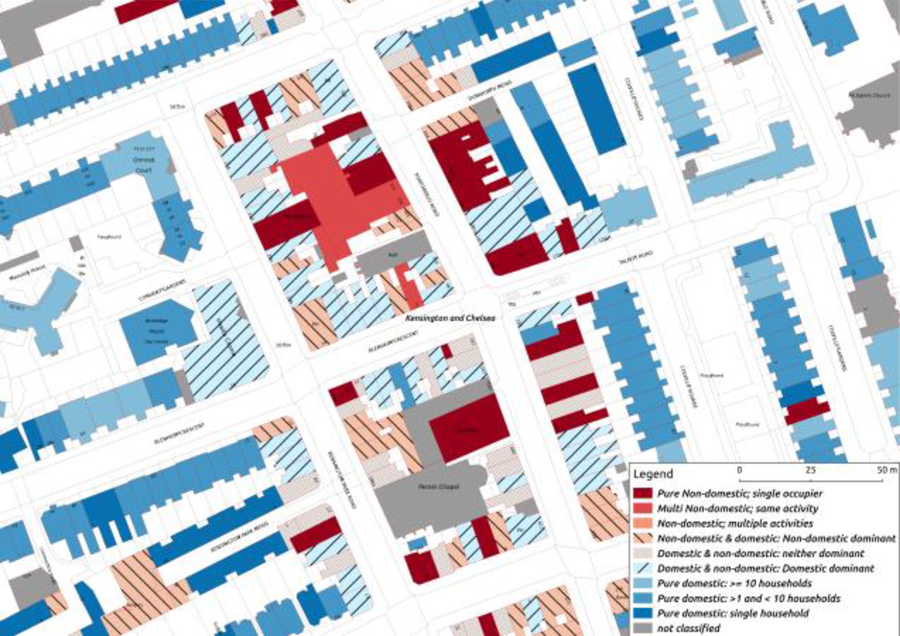
Density and compactness
Density can be measured and referred to in many different ways and for many different purposes. The most common in geographical models is to score a value per unit of area, for example population/km2. For those interested in the built environment the unit of interest might be buildings, dwellings or floorspace with values measured as counts, surface areas, volumes or some other variable. The definition of the boundary of the area part of the density calculation is important since the way it is drawn may influence the outcome of density calculation. Deciding whether the spatial boundaries should include or exclude open spaces, parks and water bodies or whether built up areas are measured to the pavement (sidewalk) edge or to the road centre line can all influence the density scores. For this work we use the postcode boundaries (polygons) available in the OS CodePoint dataset which encompass on average around 15 properties (though the number can be as low as 1 or sometimes 100 or more). The boundaries usually follow natural and man-made features that determine postal delivery areas. Postcode areas were chosen because they are the smallest statistical unit for which the UK Department for Business, Energy and Industrial Strategy (BEIS) publish domestic gas and electricity data (the next most detailed being lower layer super output areas or LSOAs). Figure 4 has an example of 3DStock and postcode boundaries in London.
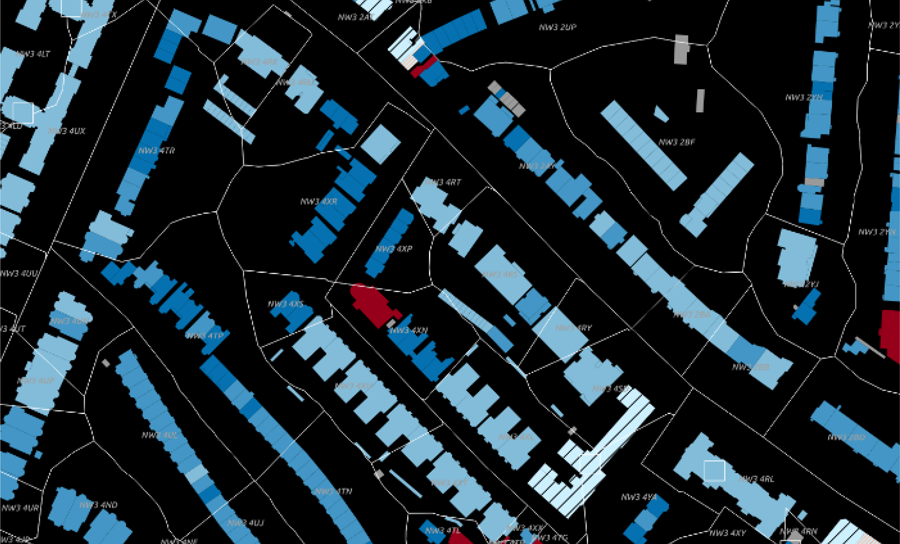
The variable that we chose to generate our density measure is the Unique Property Reference Number (UPRN), which is the unique code assigned to each individual address in the national land and property gazetteer product published by the Ordnance Survey and named AddressBase (shortened to OSAB from here onwards). In more straightforward terms UPRNs are individual addresses and counts of these may be seen as being equivalent to the numbers of non-domestic premises and dwellings. Using the postcode boundary polygon we can calculate the number of UPRNs per hectare. Whilst this includes non-domestic addresses, for areas dominated by domestic addresses this number can be treated as being roughly equivalent to households per hectare, which is commonly used when generating such statistics in the UK.
The first step in attempting to understand how energy might vary with density of the built environment was to extract built form and density data in a similar way to the work of Mitchell et al (2011) as shown in figure 2. To do this we took the 3DStock model and using the classifications of built form derived automatically in the model we aggregated the volume of each built form per postcode and expressed it as a percentage of all built form volume per postcode. This way we could show that a particular postcode was made up of say 10% detached houses, 60% semi-detached houses and 20% terraced houses by volume. At the same time, we recorded the number of domestic and non-domestic addresses or UPRNs within each postcode and calculated the number per hectare. This variable is comparable to that recorded by Mitchell et al, although we include the non-domestic built stock, while they focussed purely on dwellings.
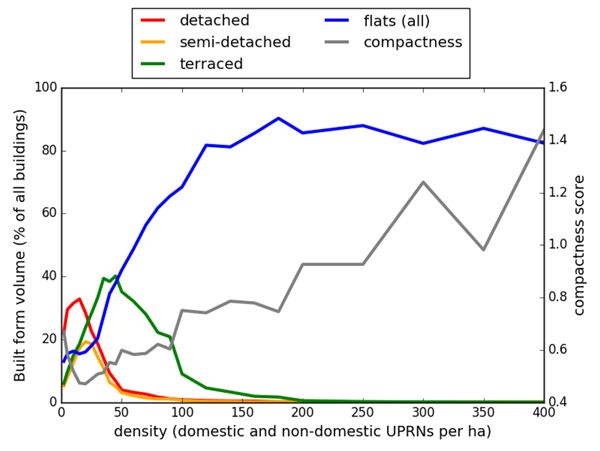
By grouping the data into density bins it was possible to produce aggregate statistics for each bin from all areas in the model. Note that the number of postcodes per bin tends to decline as density increases, with relatively few postcodes being available at the highest densities. For example, the bins up to 100 UPRNs per hectare contain on average 2,631 postcodes per bin. At densities greater than 100 UPRNs per hectare this declines such that bins in the range 250 to 400 UPRNs per hectare have on average 351 postcodes per bin. The results (in figure 5) show a similar but slightly different graph to the one shown by Mitchell et al. Detached houses are dominant at the lowest density but at around 30% of the stock this is less than the ~60% that Mitchell et al found. This may be because:
- We record the volume of each building whereas Mitchell et al recorded
- We include the volume of all built forms (domestic and non-domestic) in each postcode, and report domestic as a percentage of this total. Hence the presence of non-domestic at low densities can result in detached houses appearing to represent a lower overall percentage than might be expected from a ‘domestic only’ model.
- Mitchell et al worked with all wards in England. Many of these will have very low densities and a predominance of detached houses (such as in rural areas). The 3DStock model on the other hand is currently dominated by inner London Boroughs with only the hinterlands of Swindon and Milton Keynes contributing low density locations. In the future, when the model is extended to include more rural locations we might expect to see detached houses becoming more dominant at the lower densities.
Apart from these initial differences the chart presents a similar picture to the one shown in figure 2. As in Mitchell et al semi-detached dwellings peak at around 30 UPRNs per hectare and terraced housing peaks near to
50 UPRNs per hectare before dropping away. Flats become the dominant built form once densities rise above 50. In the 3DStock model we differentiate what are probably converted flats from purpose built flats as well as flats above shops and other non-domestic activity. In figure 5 we combine all of these together in one category so that direct comparisons with Mitchell et al can be made. Once the chart moves above 200 UPRNs per hectare the results become more erratic due to there being far fewer postcodes with these higher densities and thus the population of addresses is also greatly reduced.
A fifth line is added to figure 5 which records ‘compactness’ with the values shown on the right hand axis. Again this is measured directly from the 3DStock model but requires more explanation. Our definition of ‘compactness’ is based on a measure devised by the Building Performance Research Unit at Strathclyde University (Architects’ Journal 1970). The members of the Unit were interested in the effects of compactness on several aspects of the performance of schools, including heat loss. They measured the total area of exposed walls and roof of a building, and measured its volume. They took a hemisphere of the same volume as the building, and measured the area of its curved surface (only). They then divided the curved surface area of the hemisphere by the exposed surface area of the building, to obtain an index with a value between 0 and 1.
Our measure is similar, except that we compare the exposed surface area of the building with the surface area of five faces of a cube, excluding the bottom face. This is on the assumption – since the interest here is in space heating – that heat lost to the ground is negligible compared with the walls and roof. Now a real detached building with the form of a perfect cube has a compactness value of 1, and other more complex forms have values below 1, getting smaller as those forms become less compact. Values above 1 are possible when a building has several party walls which do not count as exposed surface area (or when a building is more like a sphere than a cube, although this is not possible currently in 3DStock).
Since we are interested in aggregated data at the different density levels it is necessary to provide an aggregate of compactness whilst at the same time avoiding averaging the compactness per postcode and then averaging these results depending upon which density bin they are allocated to. To achieve this, we estimated the ‘postcode compactness’ by treating the overall stock for each area as a single large built form: for each postcode, the actual total exposed surface area of the stock is compared with a cube of the same volume.
The results shown in figure 5 show that compactness initially falls as density increases from 1 UPRN per hectare to around 15 UPRNs per hectare before rising steadily from a compactness score of just under 0.6 to a score of 1.0 or more by the time we reach densities of 250 UPRNs per hectare. Those postcodes that score a compactness of 1.0 or more are probably not scoring this because the building mass is similar to a cube but because many of them share party walls with buildings in other postcodes, reducing the exposed surface area for the building mass in that postcode that is compared to the surface area of the five faces of the free-standing cube of the same volume.
Putting energy data into the 3DStock model
The UK Department for Business, Energy and Industrial Strategy (BEIS) collect gas and electricity meter data from the energy providers in order to monitor energy use in England and Wales. They perform analysis on this data at the meter level but this is not publicly available. They do however aggregate the data and make these aggregations available online through their website. Non-domestic gas data are only published at middle layer super output areas (MSOA) which usually cover a large spatial extent making disaggregation down to the building level very difficult while non-domestic electricity data are often aggregated to the local authority level (covering an even larger spatial extent than MSOAs). Domestic data however is published at both lower layer super output area (LSOA) and (experimentally) at postcode level. These two levels of aggregation, in particular the postcode level, means it is possible to associate these aggregate energy data with the domestic data that we have at the building level in 3DStock with reasonable accuracy.
The data in 3DStock was aggregated to the postcode level as has already been described for the built form data. In this process we also aggregated the domestic floorspace in the model and the number of domestic UPRNs per postcode. For the purpose of this work each domestic UPRN is considered to represent one dwelling. This means that the aggregated floorspace, compactness and number of UPRNs per postcode can be matched or ‘joined’ to the domestic energy data for the same postcode.
The domestic energy data have several fields which could be used for this analysis but we chose to use two key fields. The first was the number of energy meters for the postcode. The second was the total amount of energy used per year in kWh at the postcode level. By combining this with the total domestic floorspace within 3DStock for the postcode it was possible to generate aggregate domestic Energy Use Intensity (EUI) values at the postcode level as kWh per square metre per annum. This method has one major flaw. In some postcodes it might be the case that not all buildings have a gas meter and use electrical heating rather than gas. Furthermore this substitution of electrical heating over gas heating might itself be linked to density, as many houses that are converted to flats in urban areas choose to use electrical heating. This is noted in an Ofgem report which states that 25% of all flats in Great Britain use electricity for heating, compared to only 4% of houses (Ofgem, 2015, p.19). Another issue is that BEIS is not allowed to publish individual meter data, yet some postcodes may be small enough to contain only one gas meter. This means that some data are suppressed by BEIS to prevent disclosure of individual meter data in these postcodes.
Added to this the method of classifying gas meters as either domestic or non-domestic depends not on the type of building they are attached to, but their total annual consumption (BEIS, 2018, p.21): when their annual consumption is above 73,200kWh per annum they are classified as non-domestic whilst below this threshold they are considered to be domestic. By studying the numbers of domestic gas meters (in the aggregate postcode statistics) in some areas with purpose built blocks of flats it has become clear that some of these blocks are served by one gas meter which feeds a boiler which then provides heating to all flats in the block on a communal basis. Because the total consumption is large these meters are not included in the published domestic gas data. Conversely, buildings with small non-domestic activity such as small offices, shops and estate agents might be heated by gas but with annual consumption that is below the 73,200kWh and hence included in the domestic statistics. BEIS acknowledges the latter (stating that 500,000 non-domestic meters may be wrongly classified as domestic p.21), but they do not acknowledge the former not being classified as domestic. There should not be a similar problem with electric meters since these are usually classified by their end use (Profile Class) rather than their level of consumption, although there may be a few cases where activity has switched between domestic and non-domestic but somehow the energy companies have not been informed of the change.
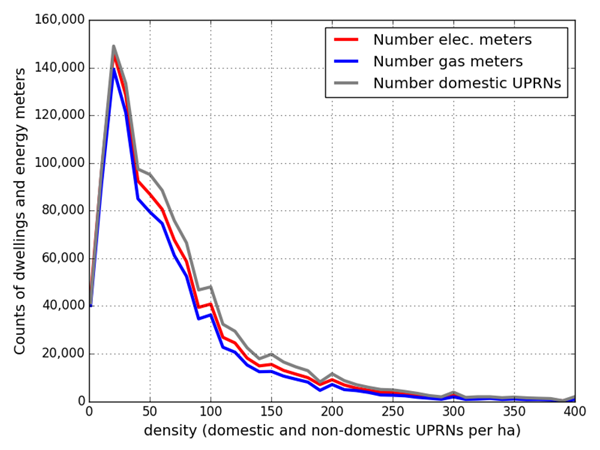
The effect of the ‘missing’ domestic gas meters can be observed when the total counts of domestic gas and electricity meters are plotted into density bins along with the number of domestic UPRNs as in figure 6. Here we can see that the number of gas meters falls short of the number of electricity meters which itself is normally slightly lower than the total number of domestic UPRNs or dwellings. Notice how the difference is far less noticeable at the lower densities but that after around 25 UPRNs per hectare the differences become much more pronounced. This is fairly logical since according to figure 6, at these lower densities, the domestic stock is dominated by detached, semi-detached and terraced houses with just single households in occupation. In the vast majority of these cases (where gas is available) we would expect each house to have one UPRN, one gas meter and one electricity meter. As the density increases beyond 40 UPRNs per household we would expect the complexity of the relationships between meters and households to increase. At higher densities the topology or web of relationships between households and buildings (and even small premises such as shops below flats) can become increasingly complicated, with some meters being shared by occupants. For the energy it is possible to think of many different potential combinations that might be ‘metered in various idiosyncratic ways to the point where some individual activities may be in part or fully indistinguishable’ (Neffendorf et al 2009, p. 45).
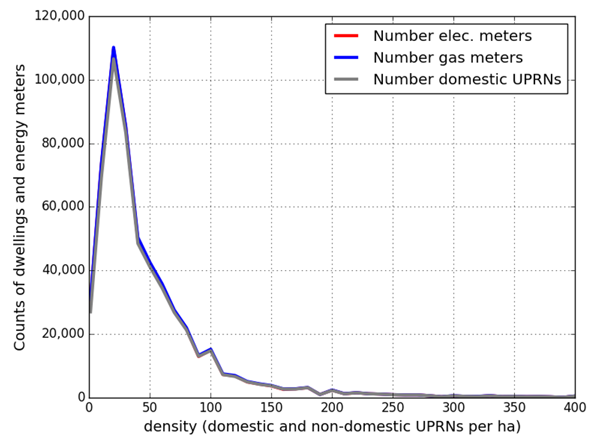
Currently there is no way of identifying individual dwellings that do not use gas, are missing gas meters, or have been misclassified within the BEIS aggregate energy data. However, these buildings are likely to have substantially different energy use intensities from the overall (gas heated) domestic stock. For example, electrically heated dwellings will have much higher electricity and low or zero gas consumption. In order to focus on gas-heated dwellings, internal consistency checks were carried out on the data provided for each postcode. Only those postcodes where the number of domestic gas meters equals or exceeds the number of domestic UPRNs are included in the analysis that follows. In this way we can be fairly sure that the floorspace in the postcode is mostly heated by gas. The results of this process are shown in figure 7 which can be directly compared with figure 6. Although the total counts have dropped slightly compared to figure 6, this figure shows a much tighter relationship between the number of domestic UPRNs and the number of energy meters at each density aggregation.
Results
By combining the detailed domestic floorspace data contained in the 3DStock model with the aggregated gas and electricity meter data, (also at postcode level) and filtering out any cases where the numbers of meters do not match the number of domestic UPRNs, it is possible to produce aggregate EUI results at the postcode level. As with all the other data shown in this paper, the data were then aggregated into ‘density buckets’ to show how EUI changes with density across the 3DStock model.
The results for median gas and electricity are shown in figure 8 (below). They show that for the current extent of 3DStock, gas consumption per square metre decreases as density increases, and that this decrease is not insignificant, with median consumption at 150 UPRNs per hectare being around 75% of that at 15 UPRNs per hectare. As has been previously noted, the really high densities of 250 UPRNs per hectare or more have far fewer postcodes and so the results should be treated with more caution. But the overall trend is quite unmistakable.
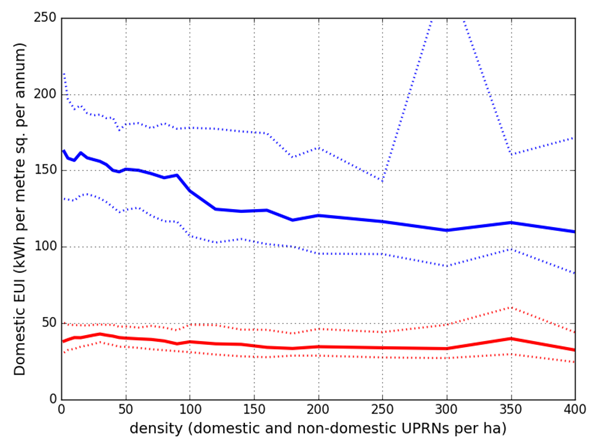
It would be easy to overlook the EUI data for electricity since compared to gas it shows far less change. Nonetheless it is apparent that, reading from low densities to high densities, after an initial increase EUI then declines from around 40 kWh/m2/annum to around 34 or 35kWh/m2/annum before rising back up to 40kWh/m2/annum at 350 UPRNs per hectare (although the data are much more sparse at this density). Note that while the absolute difference is visually less impressive for electrical EUIs (in figure 8), this still represents a 12- 15% drop in energy use per square metre. Furthermore, within the UK, the carbon intensity of mains electricity is approximately double that of natural gas (figure 9). The result is that, while electricity represents around 16% of the observed drop in total energy use between 25 and 200 UPRNs per hectare, it accounts for 28% of the change in emissions.
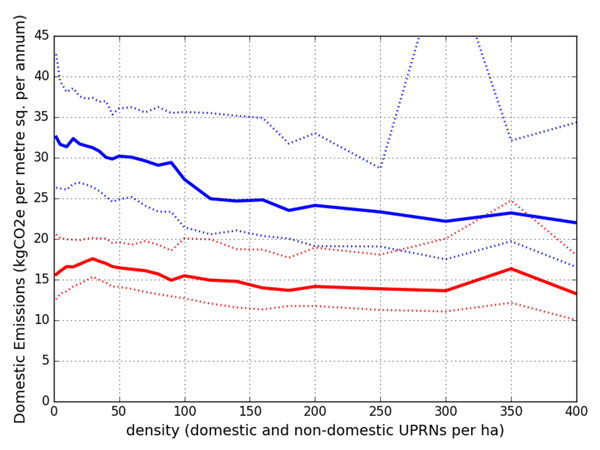
We do not pursue this analysis into areas with densities above 400 UPRNs per hectare, since the number of data points becomes small. There are nevertheless good reasons to expect gas use intensities to increase again, where these densities are achieved in high-rise blocks. This effect is show by Hamilton et al (2017). On the other hand EUIs in high-density low-rise developments might well continue the trends seen in figure 8.
The reader should note that all the figures generated from the 3DStock model are comparable in this paper in that they all show the same data on the x axis with density ranging from zero to 400 UPRNs per hectare. When figure 8 and figure 5 are viewed alongside they confirm the theory set out by Steemers, the IPCC, the NHBC and many others that increasing compactness will result in lower energy use intensity for space heating.
Conclusion
Urban areas account for large amounts of energy use yet the relationship between energy use and different spatial patterns of urban development has not been widely studied (Güneralp et al 2017). Previous research has made the link between increasing compactness and reduced energy consumption for space heating (although Salvati et al, 2017, note that the relationships may be different in other climates). Compactness and density should be closely related since built form eventually has to change as density increases.
Urban areas are often complex and ‘noisy’ environments in real life. Modelling these areas using large scale detailed stock models can result in complex and ‘noisy’ datasets which can be difficult to interpret. 3DStock is designed to be compatible with a philosophy of what has been termed ‘energy epidemiology’, in which actual consumption in very large populations of buildings is analysed statistically to give an accurate picture of current patterns of energy use. This can provide a platform from which simulation can then be used to explore future scenarios and evaluate measures and technologies for energy conservation or decarbonisation. As data become available, the method described here can be reapplied for later snapshots of the building stock, to provide indications of trends in energy use at high levels of spatial granularity, which may then be extrapolated into the future. Also, for large scale planning design, the results suggest how the compactness and density of buildings can affect energy use, which may then be used to influence the design and optimisation of designs at such a scale.
Using a detailed empirical model like 3DStock it is possible to cover large spatial extents and record detailed geometrical attributes for both domestic and non- domestic buildings. From this model it is possible to extract data for hundreds of thousands of buildings in order to both simplify this complexity and to test theories such as those on compactness and energy use. This paper started by illustrating how the model shows built form and compactness change with density. Subsequently, by combining domestic floorspace along with publicly available data on electricity and gas consumption in dwellings, it is possible to produce aggregate energy use intensity figures. When these EUIs are aggregated into bins of density of addresses per hectare they indicate that (on aggregate) at higher densities, gas consumption is 75% that of lower densities and electricity consumption is 85% that of lower densities. Although this is not as much as the 40% improvements between detached houses and apartments predicted by Steemers (2003), it does strongly support previous theoretical statements about compactness and energy use. We would argue that more work on the spatial patterns of energy use in the built environment should be pursued so that this can inform future simulations and future policy decisions in this field.
Acknowledgements
Data provided by the Valuation Office Agency (VOA) contain public-sector information licensed under the Open Government Licence v1.0. Map data © Crown Copyright and Database Right 2018. Ordnance Survey (Digimap Licence) supplied by the Ordnance Survey/EDINA service. This work was supported by the Engineering and Physical Sciences Research Council (EPSRC) funded ‘Research Councils UK (RCUK) Centre for Energy Epidemiology’ under EP/K011839/1.
Publication details
Evans, S., Steadman, P., Godoy-Shimizu, D. and Liddiard, R. (2018) Building stock modelling and the relationship between density and energy use (pdf, 8 pages. Opens in new tab). Proceedings of BSO 2018: 4th Building Simulation and Optimization Conference, Cambridge, UK: 11-12 September 2018.
Banner photo credit: Alireza Attari on Unsplash
